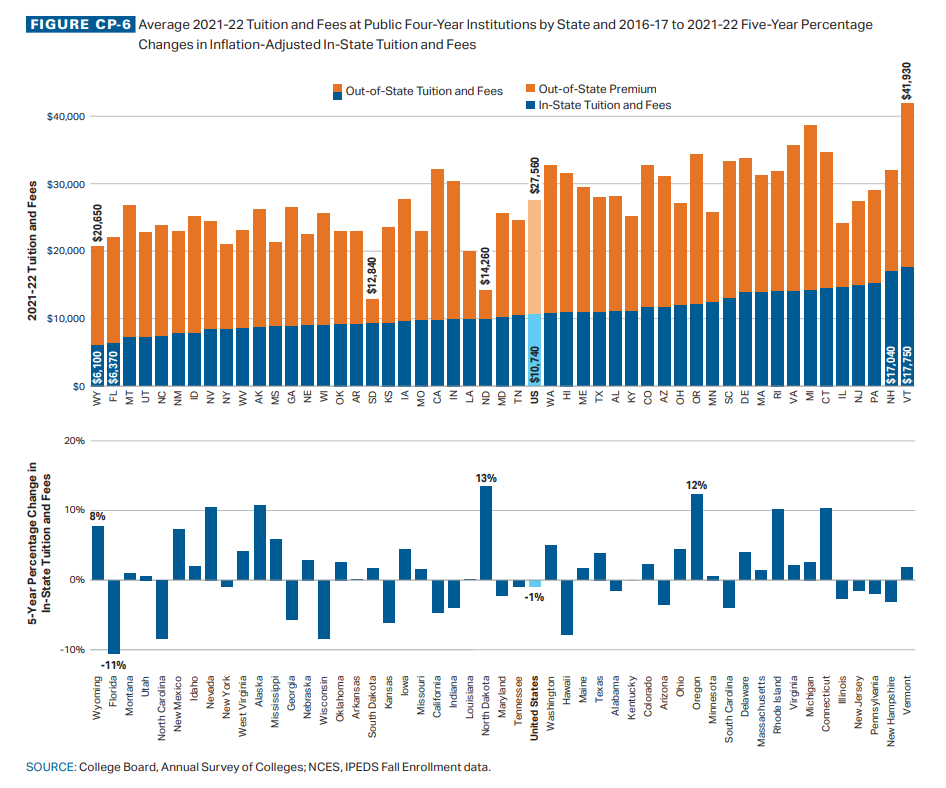When deciding which colleges to apply to, one of many decisions you’ll have to make is whether you want to attend an in-state or out-of-state institution. Cost is a big difference between the two. Students who choose to attend an in-state college pay in-state tuition, which brings up the question, what does that mean and why does it cost less? Here’s what you need to know.
What Is In-State Tuition?
In-state tuition refers to the tuition fee students pay to attend a college or university in their state of residence. Students who attend in-state public or state colleges or universities pay considerably lower tuition fees than out-of-state students. This is because these institutions receive state funding to help subsidize the cost of higher learning. The reduced rates are only applicable to students who are residents of that state.
The exact difference in rates for in-state vs. out-of-state students varies among states. However, the one basic principle remains the same – only students who are residents of the state benefit from the lower tuition fees. That’s because the funding that public colleges and universities get comes from taxes paid by in-state residents. The reasonable expectation then is that only residents of the state should benefit from it.
There may be a few exceptions such as reciprocity states and a few colleges that allow all students who enroll in online classes to pay in-state tuition regardless of their state of residence.
Basic Requirements
Meeting the residency criteria is the primary requirement for students to qualify for in-state tuition. However, the specific residency policy may vary from one state to another. In general, all states require prospective students to be living in the state for a specified minimum period of time before enrolling in an in-state school.
For example, if you’re a resident of California, you may qualify for subsidized in-state tuition if you attend any public college or university in California. However, this lower cost does not apply if you attend an institution outside California. Similarly, students who are not residents of California can attend any school within the state but they won’t qualify for in-state tuition.
To benefit from the lower cost of attendance, it’s important to understand the specific residency requirements of your state. To receive these benefits, you will have to submit documentation demonstrating that you’ve been living in the state for the required period of time. Again this varies among states. In most cases, you will need to submit proof of permanent residence, a driver’s license, vehicle registration, or voter registration.

Pros And Cons Of Attending An In-State School
Attending an in-state school has its own set of pros and cons.
The lower cost of attendance is the biggest appealing factor of attending an in-state college or university. It can save you thousands of dollars in tuition fees, which likely means graduating with less student debt compared to your out-of-state peers. And if you choose a school close to home, you could save even more on accommodation.
A disadvantage of choosing an in-state school could mean limiting some of your choices. It can be great if you find a college that offers everything you’re looking for in terms of academic programs as well as extracurricular facilities. However, if you can’t find a school that ticks all the boxes, you may have to compromise between the lower fees of in-state schools and your preferred program in an out-of-state college.
What Is Out-of-State Tuition? What Is The Difference In Cost?
Out-of-state tuition refers to the tuition rate you would pay to attend a public college or university in a state other than your state of residence.
The difference in cost between in-state and out-of-state tuition varies. Regardless of the exact difference, out-of-state tuition is, in most cases, considerably higher than in-state tuition. Out-of-state students can pay as much as double or even triple what in-state students pay to enroll in the same program in the same school.
A look at this 2021 College Board report on Trends in College Pricing offers some interesting insights into the difference in costs between in-state and out-of-state tuition. According to the report, in 2021- 2022, the average in-state tuition at a public four-year college was $10,740. In comparison, during the same period, the average out-of-state tuition at a public four-year college was $27,560. So if you attend an out-of-state college, you can expect to pay a lot more than your in-state classmates.
That’s a substantial difference in cost, which is something you should give serious thought to before considering this option.
So Where Should You Go?
There’s no single answer that’s right or application to everyone. The best way to determine what’s best for you is to first shortlist all the public colleges and universities in your state.
If you find an in-state college that offers the program you’re looking for and allows you to graduate with the degree of your choice, well, that’s awesome!
But, if no in-state school offers what you’re looking for academically, then you probably need to start exploring out-of-state colleges and private institutions.
Ultimately, the best-fit college for you is one that helps you achieve your educational and career goals while also being affordable.
College Raptor’s College Match Tool can help you make this choice easier. College Match helps you compare colleges based on your preferences, see your acceptance odds, and see what you will likely pay for each school.
If you want to state close to home, or at least within your state of residence, click here to find out what grants may be available for you. Another great way to keep college expenses down is with scholarships. Search our free database now to see which scholarships you may be eligible for.







